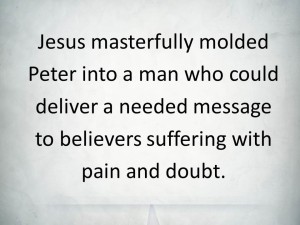Our Fall Focus this year is on 1 and 2 Peter and will begin with our next post (Thursday).
We believe this is an important study for our times, and we want to invite you to open your Bibles and study these wonderful letters with us.
We have divided our study into thirteen posts which will also be helpful for those who teach God’s word.
Join us as we set sail with Peter and learn how to live with hope in a foreign land!
(Pass on the word to others you think would be interested)
 To prepare for our study it might be helpful to look at the man God molded to communicate its message, Peter.
To prepare for our study it might be helpful to look at the man God molded to communicate its message, Peter.
The renowned artisan Michelangelo once said, “Every block of stone has a statue inside it and it is the task of the sculptor to discover it.” Peter was just a block of stone until Jesus began to form him.
Jesus saw the potential in Peter the first time they met. Jesus looked that rustic fisherman up and down and said, “You are Simon, you will be Cephas” (John 1:42). Peter learned Jesus had the ability to know what was inside a person, and even better He had the ability to change it! He could take a Simon, who like his name sake from Genesis was weak and fleshly, and could make him into a man with rock-solid faith.
Between those two phrases, “You are … you will be” lies the power of Jesus to change a life. All those who come to Jesus are somewhere in that process between what they were and what Jesus will make of them yet. The purpose of this formation is so that we may be useful to God’s purposes (2 Tim. 2:20-21).
Jesus masterfully molded Peter into a man who could deliver a needed message to believers suffering with pain and doubt. Peter knew those waters and was ready to help them traverse the rapids with safety. When it came to writing the message of 1 and 2 Peter there are three reasons why Peter was the man for the job.
 Peter Faced Persecution. Peter knew the white hot fear of persecution personally. He knew how it could bring a man to his knees. He felt it one night sitting around a fire when a servant girl asked him if he followed Jesus and he denied it, not just once, but three times – he failed and he cried (Luke 22:54-62).
Peter Faced Persecution. Peter knew the white hot fear of persecution personally. He knew how it could bring a man to his knees. He felt it one night sitting around a fire when a servant girl asked him if he followed Jesus and he denied it, not just once, but three times – he failed and he cried (Luke 22:54-62).
But later Peter found that persecution could make a person stand up taller and speak louder. As the book of Acts begins Peter no longer flinches at the pressure but stands before the Sanhedrin and says, “We ought to obey God rather than men” (Acts 5:29). The man who was frightened to confess his faith to a little girl in a dark courtyard of a private home, boldly confesses the Lord in the public courtyard of the Temple to thousands in the bright morning (Acts 2). Yes, I would say Simon became Cephas! He was perfectly suited to help believers face persecution.
Peter Came To Love All Believers. Peter played a pivotal role in showing the early church that the gospel was for all, both Jew and Gentile. Peter preached it in Acts 2 (Acts 2:39). He was used by God to share the gospel with Cornelius, and then urge the church to accept Gentiles as brothers in Christ (Acts 10, 11, 15). Yet, a few years later when Peter went to Antioch he had trouble practicing what he preached and he discriminated against the Gentile believers when he ate (Gal. 2:6-10).
Peter was a man who personally knew the struggles of maintaining a loving and meaningful fellowship between people of very different backgrounds. He had both failed and succeeded. This made Peter the right man to write about brotherly love, unity and fellowship to a church made up of Jews and Gentiles. In fact, it seems clear that the church Peter addresses in 1 and 2 Peter is largely comprised of Gentiles (see 1 Peter 1:14,18; 2:9-10, 25; 3:6; 4:3-4). This “apostle to the Jews” does a great job helping Jew and Gentiles have “sincere love for the brethren.” Peter learned it wasn’t easy, but through Jesus it could be done.
Peter Was Commissioned To Be A Shepherd. Two great fishing trips defined Peter’s life. The first one ended with Jesus saying, “I will make you a fisher of men” and it highlights Peter’s evangelistic work with the lost (Luke 5:1-10). The second fishing trip ended with Jesus saying, “Feed My sheep” and it highlights Peter’s pastoral work with the saved (John 21:15-19). Acts show us Peter the evangelist. The two letters show us Peter the shepherd. In these two letters Peter fulfills the Lord’s command to feed and tend the sheep of God, and by doing so shows how deeply he loved the Lord.
Jesus shaped Peter into a man who brought God’s grace and glory to many people. What is God shaping you to do?
Tim Jennings
timj.theway@hotmail.com
“Let all that you do be done in love” (1 Cor. 16:14)

